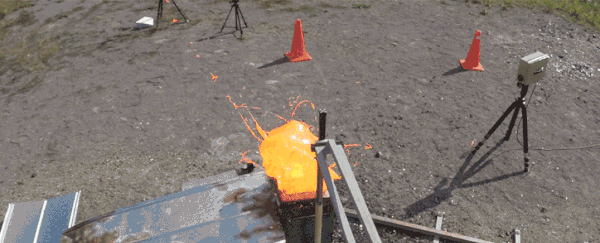Volcanic eruptions, as history has proven, can be very dangerous. And there's something that can make them even more so. When lava comes into contact with water, it can dramatically explode, like it did with Hawaii's Kīlauea and Iceland's Eyjafjallajökull - but this doesn't always happen.
The problem is, we don't really know why these explosions only happen sometimes.
So, there's only one logical response. Cook up a bunch of rock until it melts and combine it with water to try to figure out why sometimes it produces an explosion, and sometimes it doesn't.
As you've probably guessed, that's exactly what a team of geologists at the University at Buffalo in the US has been doing as a long-term, ongoing study.
"If you think about a volcanic eruption, there are powerful forces at work, and it's not a gentle thing," says Ingo Sonder of the University at Buffalo's Center for Geohazards Studies. "Our experiments are looking at the basic physics of what happens when water gets trapped inside molten rock."
Making lava is actually not all that difficult. You just need the right tools, such as a high-powered induction furnace, and the right kind of rocks.
 (Ingo Sonder)
(Ingo Sonder)
Sonder and his team use basalt, a type of volcanic rock, and chuck it into the furnace for four hours or so, until it's nice and hot - between around 1,200 and 1,350 degrees Celsius (2,192 and 2,462 Fahrenheit) - which is comparable to the higher temperatures of natural lava.
Once the lava is ready, it's poured into an insulated steel box, and water is injected into it. After the water is added, a hammer drives a plunger into the lava-water melange to help trigger an explosion.
The result is what is called a molten fuel coolant interaction, in which hot fluid - the fuel - interacts with coolant to produce a violent reaction. It's usually studied in the context of industrial safety, since these reactions can be incredibly dangerous - such as the Chernobyl, Three Mile Island and Fukushima nuclear disasters testify, to present some of the more extreme examples.
But these interactions can be pretty dangerous in volcanoes too, producing steam explosions that can send "lava bombs" flying, as we saw earlier this year when just such blob from the eruption of Kīlauea destroyed a tour boat. (No one died, but there were some pretty serious injuries.)
The dataset the team has produced from these experiments is pretty small so far, and more will be needed before the researchers can confirm their results. But the process has already helped the team identify a few trends.
So far, they have found that explosions can spontaneously occur when there's about 35 centimetres (13.8 inches) of lava in the column above the injection point.
They also found that the explosions were much bigger when the water was injected at greater speeds, and when they used taller crucibles.
There has been previous research in 1983, when scientists in Germany also found that a higher-velocity water injection resulted in a more powerful explosion. However, the volumes of lava they used were much smaller, so the University at Buffalo's team's research builds on that foundation.
And there is much more lava-exploding to be done.
"The research is still in the very early stages, so we have several years of work ahead of us before we'll be able to look at the whole range and combination of factors that influence what happens when lava or magma encounters water," said geologist Greg Valentine, director of the Center for Geohazards Studies at UB.
"However, everything we do is with the intention of making a difference in the real world. Understanding basic processes having to do with volcanoes will ultimately help us make better forecasting calls when it comes to eruptions."
Meanwhile, if you're interested in lava science, you should check out Syracuse University's Lava Project, which for the last few years has been doing fascinating things like pouring lava over ice to see what happens.
The team's research has been published in the Journal of Geophysical Research: Solid Earth.
